The Falls Bridge
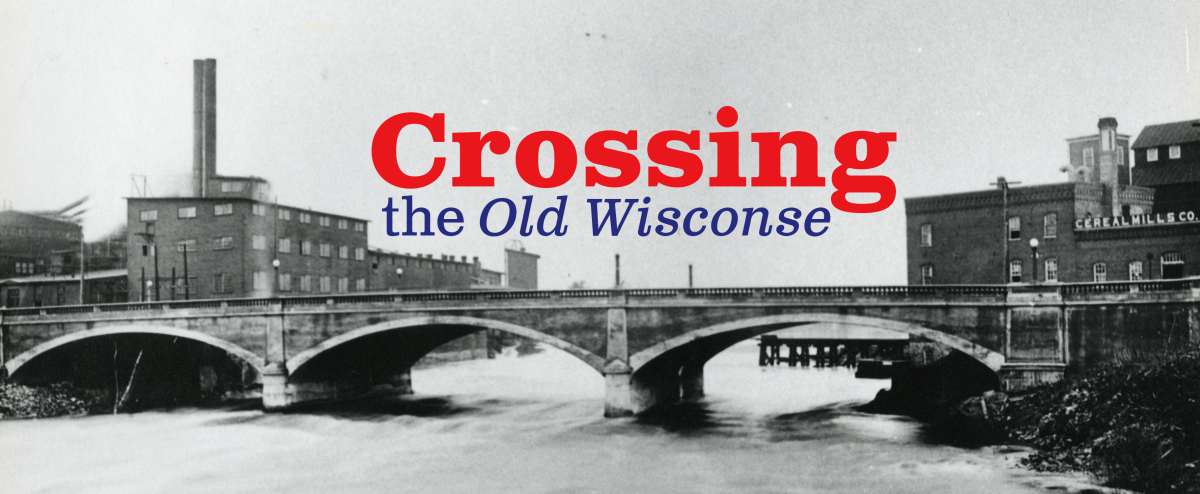
Early in Wausau’s history, a river crossing to the west bank of the Wisconsin River was likely not of the highest priority. From the 1860s until the 1880s a series of more or less temporary bridges made the crossing at the falls. These early bridges generally only survived for a short time before being washed out or simply falling into disrepair and collapsing, the best of them only managed to survive for 16 years. For Wausau’s early citizens, this was generally acceptable. The west side was sparsely populated and the early bridges would mostly have served the occasional farmer or homesteader coming into town. For more about the first Falls Bridge see "Wausau's First Bridges"
Heading West
In the 1880s as Wausau spread to the West, industry began to find its way across the river. In 1881 the Curtis and Yale Company established a sizeable plant on the west bank of the Wisconsin River not far from the Falls Crossing. The old Falls Bridge, which had stood since 1867, was replaced in 1883 by a professionally built bridge, no doubt as a result of the construction of the Curtis and Yale Plant on the West side of the river. Information on the details of this bridge are scarce and often disagree with one another. It appears that the ‘83 bridge was of mixed iron and wood construction yet some sources suggest entirely iron or even a mixture of iron and steel. What is clear is that in 1894 the bridge got a major overhaul. Non-steel members, be they wood or iron, were replaced with steel. The work significantly strengthened the bridge and at a cost of only $3,576 was far less expensive than a new bridge would have been.1 The repairs and upgrades would end up buying the bridge a further two decades of useful life, but not without issue. Extreme cold weather during the winter of 1909 caused the metalwork to become so brittle that a truss rod spontaneously shattered in the middle of the night. Somehow the bridge did not collapse and the mishap wasn’t even discovered until late the next morning. Again the bridge was repaired, with a piece of chain somewhat questionably substituted in for the shattered member.2 Shortly thereafter in the summer of 1910, a routine inspection of the bridge revealed that the new streetcar line was severely overstressing the bridge deck. All traffic over the bridge was temporarily suspended while the Wausau Ironworks conducted repairs and heavily reinforced the deck.3
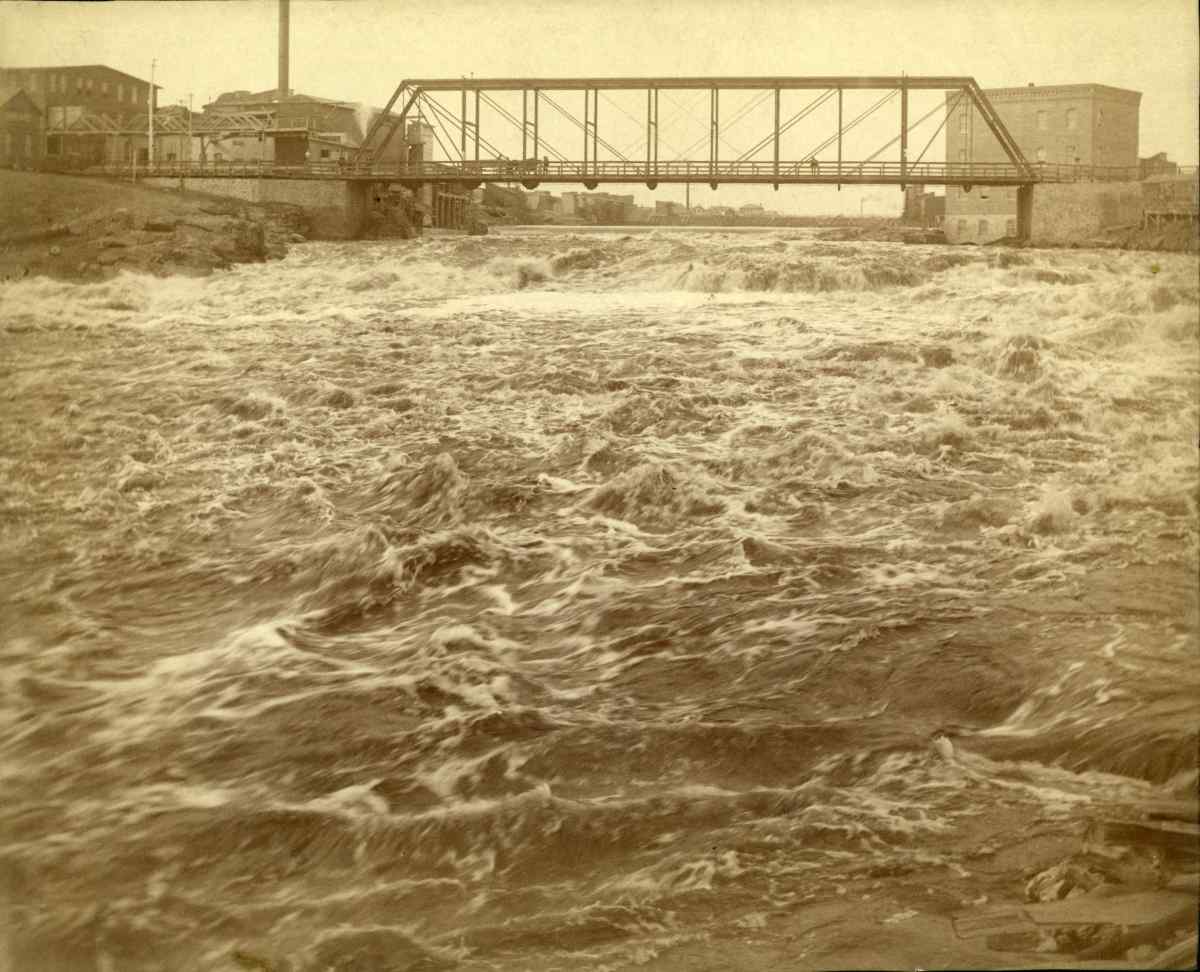
The Falls Iron Bridge Circa. 1900.
Image Credit: MCHS Photo Collection
"Liable to Go Down at Any Moment"
Despite the reinforcements, the bridge was never really the same post-1910. An inspection in 1912 showed that the bridge was still dangerously unsound and desperately needed to be replaced.4 For the next six years that was a fact of life in Wausau. It was common knowledge that the Falls Bridge was dangerous but, with the only other option being a two-mile detour across the Leah Beebe Bridge, people put up with it; even multi-ton streetcars were allowed to cross. By 1917 the community had had enough. Citizens began to wonder if the bridge was even safe enough for foot traffic, much less the kind of heavy use it was seeing. In March of that year, the Wausau Chamber of Commerce issued the following statement on the matter. “A new bridge should be built at once, as the present one is liable to go down at any moment and if it should happen it would cost the city more than all the bridges needed would cost and the lives lost could not be replaced.”5 That seems to have been all the motivation the city needed and planning for the new bridge began shortly thereafter. The new bridge would be a three-span, earth-filled, concrete arch structure; and the first major concrete bridge in the city. A project such as this would have been a massive undertaking during the best of times but with the country now officially at war and labor and raw materials in short supply things became even more difficult.
A Bridge on the Move
Construction began in October 1917,6 with Wausau Ironworks at the helm.7 Company engineers devised an ingenious solution to keep the old bridge open while allowing the new bridge to be built in the same spot. The old structure was slowly lifted six feet over the course of a month while temporary approaches allowed traffic access. With the old bridge jacked out of the way construction of the new bridge began as traffic continued to flow right overhead.8 Construction was indeed hampered by the war effort. While finding labor was a minor problem far more challenging was the lack of transportation. With most of the country’s railroads running at full capacity moving war materials, there simply weren’t any available to haul the aggregate or cement needed for the bridge. In February of 1918, with the bridge tantalizingly close to completion, work ground to a nearly month-long standstill for want of materials.9 Further excitement and delay came in April of that year when a kettle of tar being used for decking work caught fire ultimately causing little damage but no shortage of mess.10
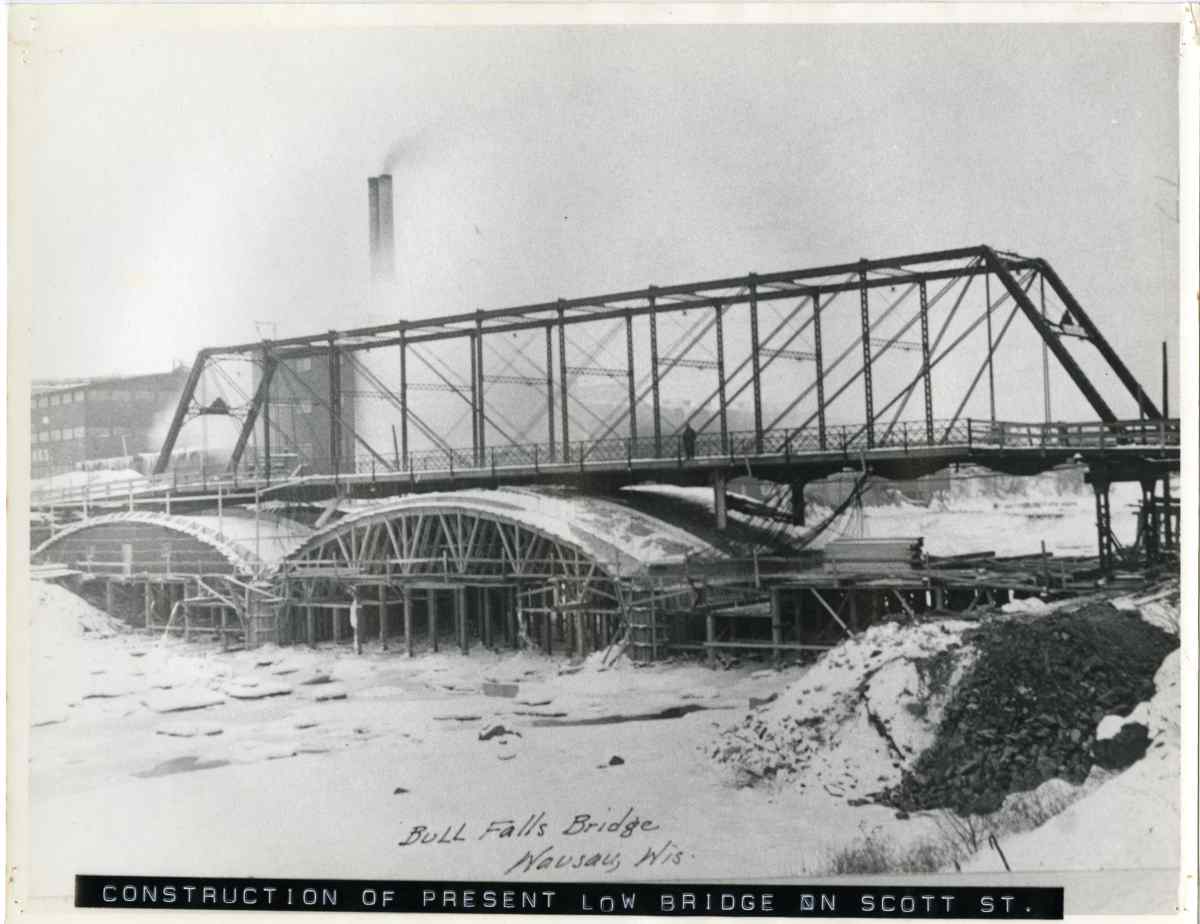
The new concrete falls Bridge rises under its iron predecessor in this 1917 dated photograph.
Image Credit: MCHS Photo Collection
By May of 1918 construction was back on track. Late that month crews began filling the arches with earth and rubble in preparation for laying the roadbed. The filling of the new bridge spelled the end for its predecessor. On May 28, 1918, the old bridge closed for the final time.11 The venerable old structure was not demolished, rather it was disassembled by Wausau Iron Works and refurbished before embarking on a long and improbable journey. The town of Galata Montana purchased the renewed bridge and used it to span the Marias River12 until the creation of Lake Elwell in 1956 when it was dragged into a nearby field and largely forgotten about. As of 2022, the 1883 Falls Bridge is still standing abandoned on the shore of Lake Elwell. At 139 years old and counting it is undoubtedly the oldest of Wausau’s bridges still in existence.

The Falls Iron Bridge as it sits today, abandoned near Lake Elwell, Montana.
[Image Credit:In June of 1918, the new Falls Bridge opened with surprisingly little fanfare; this is likely because the bridge was not entirely complete: lacking sidewalks, railings, and a streetcar crossing. It would not be until August of 1918 that the Falls Bridge was truly finished when the Wisconsin Valley Electric Company was granted a franchise to lay streetcar tracks and the permanent road surface was installed around them.13 For information see
The Battle of Falls Bridge
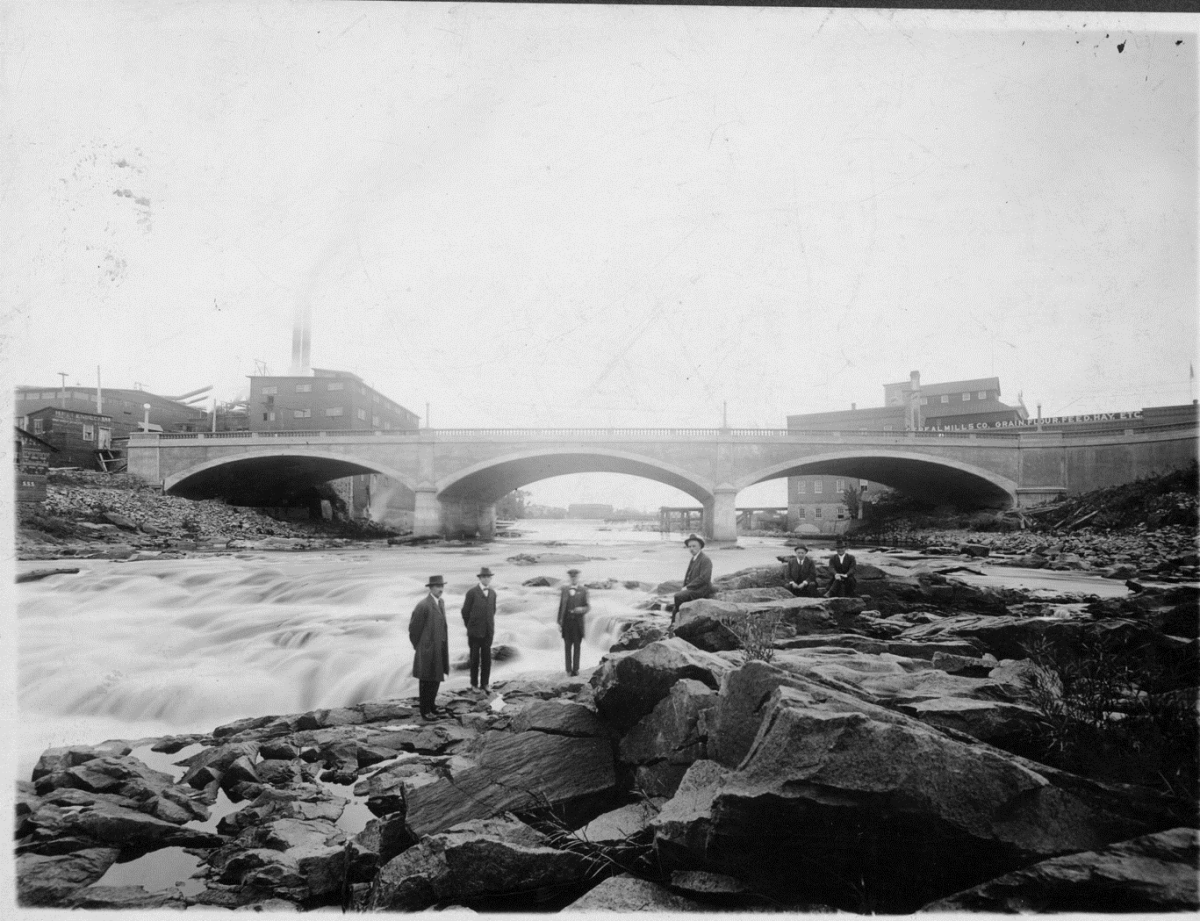
The Concrete Falls Bridge shortly after opening.
Image Credit: MCHS Photo Collection
The Leaning Bridge of Wausau
The 1918 bridge’s life was more or less uneventful; built from concrete and earth it was much less prone to sudden failures or rapid deterioration than its wooden and steel predecessors. At 70 feet wide (more than double that of its predecessor) the bridge was also sufficient to handle four lanes of automobile traffic even as cars got larger and faster throughout the decades. It wasn’t until 1990, 72 years after it had been built, that the bridge began to show signs of needing replacement. A routine inspection revealed that years of heavy traffic, harsh winters, and road salt had begun to eat away at the concrete structure.14 More concerning was the discovery that the southern wall of the bridge had tipped 4 ½ inches.15 All eastbound lanes were immediately closed as a solution was sought. At that point, the bridge was seeing some 30,000 crossings daily,16 and its closure was extremely concerning to commuters and business owners alike. Restaurant owner Billy Moy wrote to the Wausau Daily Herald stating that his customers had to go twenty blocks out of their way to reach his restaurant17 and city officials received dozens of complaints from commuters noting traffic jams, delayed busses, and increased travel times in the downtown area.1 City engineers eventually devised a clever solution to the tilting bridge. It was determined that the northern wall of the bridge was in extremely good condition for its age. Over just one month, contractors ran a series of tension rods through the bridge, and by applying several thousand pounds of force to the good wall, the tipping southern side was brute-forced back into position.19
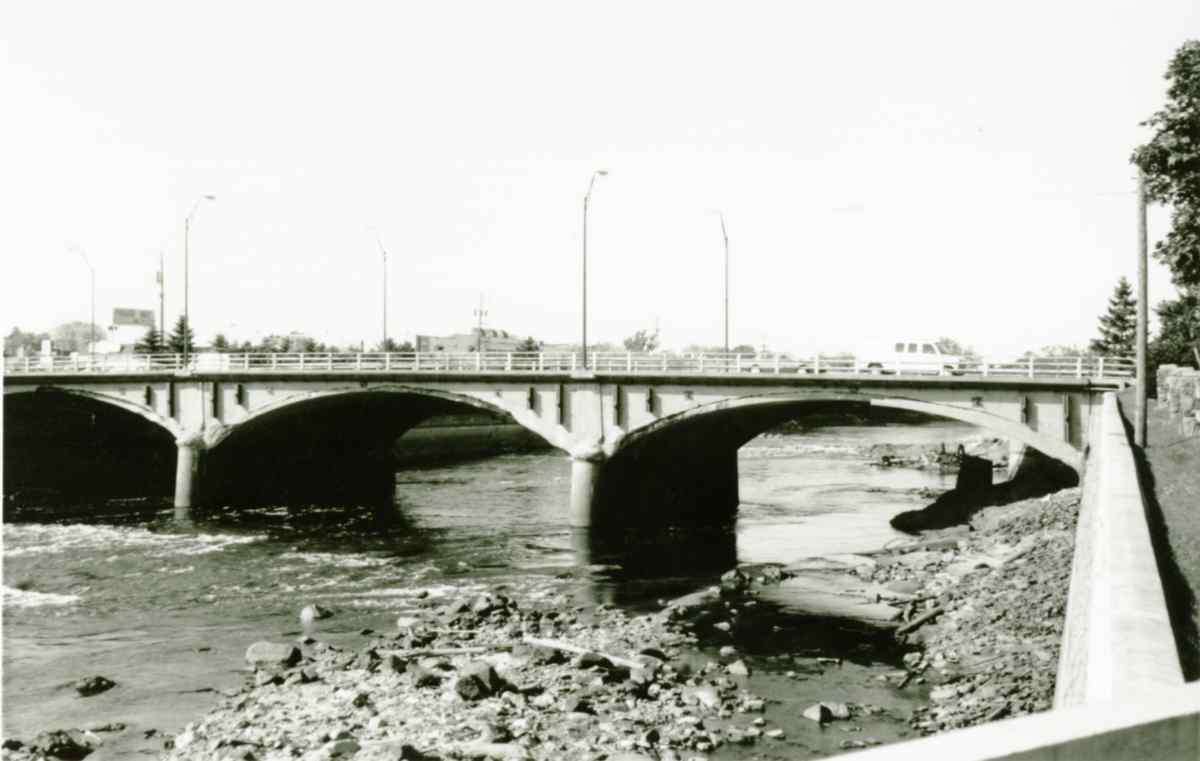
A series of steel cable braces hold the crumbling Falls Bridge together in this 1992 photo.
Image Credit: MCHS Photo Collection
A Priority Project
With the bridge temporarily back in service efforts turned toward planning its replacement. Initially, the patched-up Falls Bridge was supposed to come down in 199120 but a lack of federal funds due to the Gulf War recession forced the project to be pushed back repeatedly. Much to the credit of the city engineers and contractors, no further shifting was detected in the weakened southern wall of the bridge.21 It remained open as officials petitioned Madison to have the bridge reclassified as a priority project. The bridge again made headlines in 1992, this time for dramatically shedding hundred-pound chunks of concrete from its ever-troubled south side. Pieces of concrete hung down from the bridge, suspended by cables and rebar creating a potential hazard to boaters and more than a little unease among those who crossed the bridge. The terrifying spectacle may have worked in favor of those fighting to have the bridge replaced. Shortly after images of the crumbling bridge were published, State funding was secured and the project timetable was moved up two years from 1998 to 1996.22
Two For One
The plan was to replace the bridge in two phases. A three-lane eastbound bridge linking Washington Street and Stewart Avenue would be built in 1996 followed by a nearly identical bridge for westbound traffic and connecting Scott Street and Stewart Avenue the following year. Zenith Tech of Waukesha was given the $2.3 million contract for the construction of both bridges.23 The decision to build a pair of bridges was the result of the need to streamline traffic flow to and from the downtown area. With just one Falls Bridge eastbound traffic was forced to make a series of awkward and hazardous turns to line up with the slough bridge heading downtown. Large vehicles such as semi-trucks found the corners difficult to navigate and this led to traffic jams, especially during rush hour. Construction of the eastbound bridge began in April 1996. The construction included the widening and resurfacing of a portion of Stewart Avenue which led to an infamous event in Wausau’s recent history. The cluster of 13 telephone poles, which had garnered so much criticism when erected in 1979, was quietly dismantled one evening in May of 1996.24 Not even the creator Ed Schoenberger was notified. "I would have liked to at least attended the wake, see them tear it down," Ed said. "I guess progress is progress, no matter what you destroy… but at least send me a Hallmark card. Care enough to send the very best.25
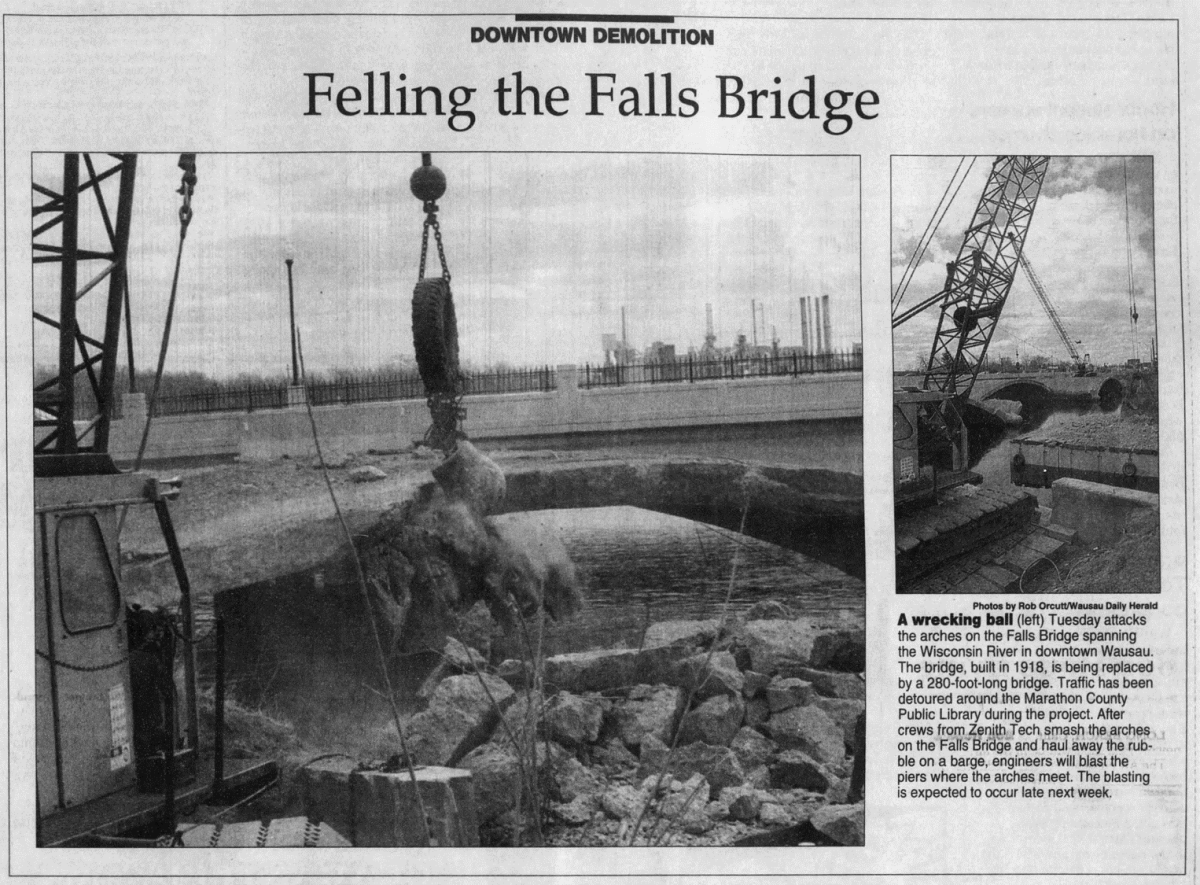
Credit: Wausau Daily Herald April 23, 1997
The old Falls Bridge closed for demolition in March 1997.26 The old bridge proved resilient despite its advanced age. Excavators employed in the demolition were able to rest on the bridge itself even as they worked to destroy it. Eventually, a wrecking ball and even dynamite were employed to bring down the Old Falls Bridge. Construction of the new westbound bridge was completed over the course of six months; opening on September 23, 1997, one day ahead of schedule.27 With a projected lifespan of 80 years, Wausau’s Twin Falls Bridges should continue to serve the community for decades to come.
< Previous Story Glossary Main Index Next Story >
1. “Travel Was Difficult In Marathon 60 Years Ago.” Wausau Daily Herald (Wausau), December 23, 1909.
2. “Bridge Support Breaks.” Wausau Daily Herald (Wausau), December 27, 1909.
3. “Too Close Falls Bridge.” Wausau Daily Herald (Wausau), July 20, 1910.
4. “Bridges In Poor Condition” Wausau Pilot (Wausau), April 30, 1912.
5. “The Falls Bridge.” Wausau Pilot (Wausau), March 13, 1917.
6. “Pouring Concrete.” Wausau Daily Herald (Wausau), October 22, 1917.
7. “Bids are opened.” Wausau Daily Herald (Wausau), September 19, 1917.
8. “Raising Bridge.” Wausau Daily Herald (Wausau), November 13, 1917.
9. “Short Items.” Wausau Pilot (Wausau), February 19, 1918.
10. “Fire Department Calls.” Wausau Pilot (Wausau), April 23, 1918.
11. “Close Bridge.” Wausau Daily Herald (Wausau), May 28, 1918
12. Close Bridge
13. “To Resume Service.” Wausau Daily Herald (Wausau), August 13, 1918.
14. “Falls Bridge Falling.” Wausau Daily Herald (Wausau), March 6, 1990
15. “Crumbling bridge closed for repairs.” Wausau Daily Herald (Wausau), March 2, 1990
16. “Falls Bridge Falling,”
17. “Bridge vs. business.” Wausau Daily Herald (Wausau), March 7, 1990
18. Bridge vs. business
19. “Falls Bridge work ahead of schedule.” Wausau Daily Herald (Wausau), March 22, 1990
20. Falls Bridge work ahead of schedule
21. “Dangling concrete removed from the bridge.” Wausau Daily Herald (Wausau), February 7, 1992.
22. “Downtown Falls Bridge may be replaced in ’95.” Wausau Daily Herald (Wausau), December 3, 1993.
23. “New Bridge.” Wausau Daily Herald (Wausau), March 8, 1996
24. “Progress uproots ‘Pinery’ sculpture.” Wausau Daily Herald (Wausau), May 10,1996.
25. Progress uproots 'Pinery' sculpture
26. "Bridge replacement will cut traffic flow.” Wausau Daily Herald (Wausau), March 1, 1997.
27. “New Falls Bridge set to open Tuesday.” Wausau Daily Herald (Wausau), September 19, 1997
